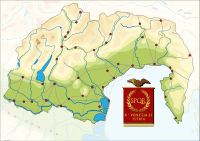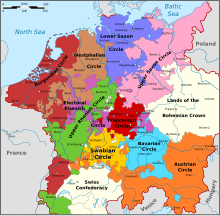District of Albona
A District is one of the lowest Administrative Division that, in some countries and at various historic times, was managed by the local government, and such was Albona.
The 10th century the Byzantine Eastern Roman Emperor Constantine VII Porphyrogenitus in his De Administrando Imperio named Albona as "Castron Albonos".
Albona is 315 meters high from the sea level and was called hill fort or "castors" or "castrum" in Latin.
In 7BC, Augustus divided Italy into 11 Regions; I Latuum et Campania, II Apulia et Calabria, III Lacania et Bruttium, IV Smnium, V Picenum, VI Umbria et Ager Gallicus, VII Etruria, Viii Aemilia, IX Liguria, X Venetia et Histria, XI Transpadena.
Under Emperor Antoninus Pius they created the military Region "Praefecturae Italiae et Alpinum" which included Itria and all of the Liburia.
The X Regio, Triveneto was divided into 17 "Compartments"[3] or Provinces of the Administration division of the Empire, or Territory, Region, Canton, District, and was called "Venetia et Histria" in Latin.
The 17 Compartments or Provinces; Belluno, Balzano, Gorizia, Padua, Pordenone, Rovigno, Trieste, Treviso, Albona, Fianona, Udine, Verona, Vicenza, Pula, Fiume.
The three Secular Regions of Trentino-Alto Adige, Friuli-Venezia Giulia, and Veneto had four Provinces; Gorizia, Trento, Udine, Venice.
The Istrian Circle was divided into Districts; Bellai, Buie, Albona, Capodistria, Cherso, Dignano, Lussino, Montona, Parenzo, Pisino, Rovigno, Pola, veglia, Volosca.
[6] In 1796 in the repartition of the Napoleonic Empire, the Cisalpine Republic and Maritime Austria were formed and divided into 20 Departments; Olone, Verbano, Lario, DelleMontagne, Tessino, Adda, Serio, Mella, Benaco, Upper Po, Miuccio, Crostolo, Apennines, Panaro, Reno, Upper Padua, Lower Po, Lamone, Rubicon.,[7][8] In 1797 France treaty gave Istria to Austria.
Istria was divided into six Cantoni or Districts; Capodistria, Pirano, Parenzo, Rovigno, Dignano, Albona.
Districts of the Province of Istria; Capodistria, Muggia, Pirano, Umago, Citta Nuova, Parenzo, S.Lorenzo, Rovigno, Pola, Dignano, Valle, Albona, Montona, Grisignona, Portole, Buie, Raspo, S.Vincenti.


